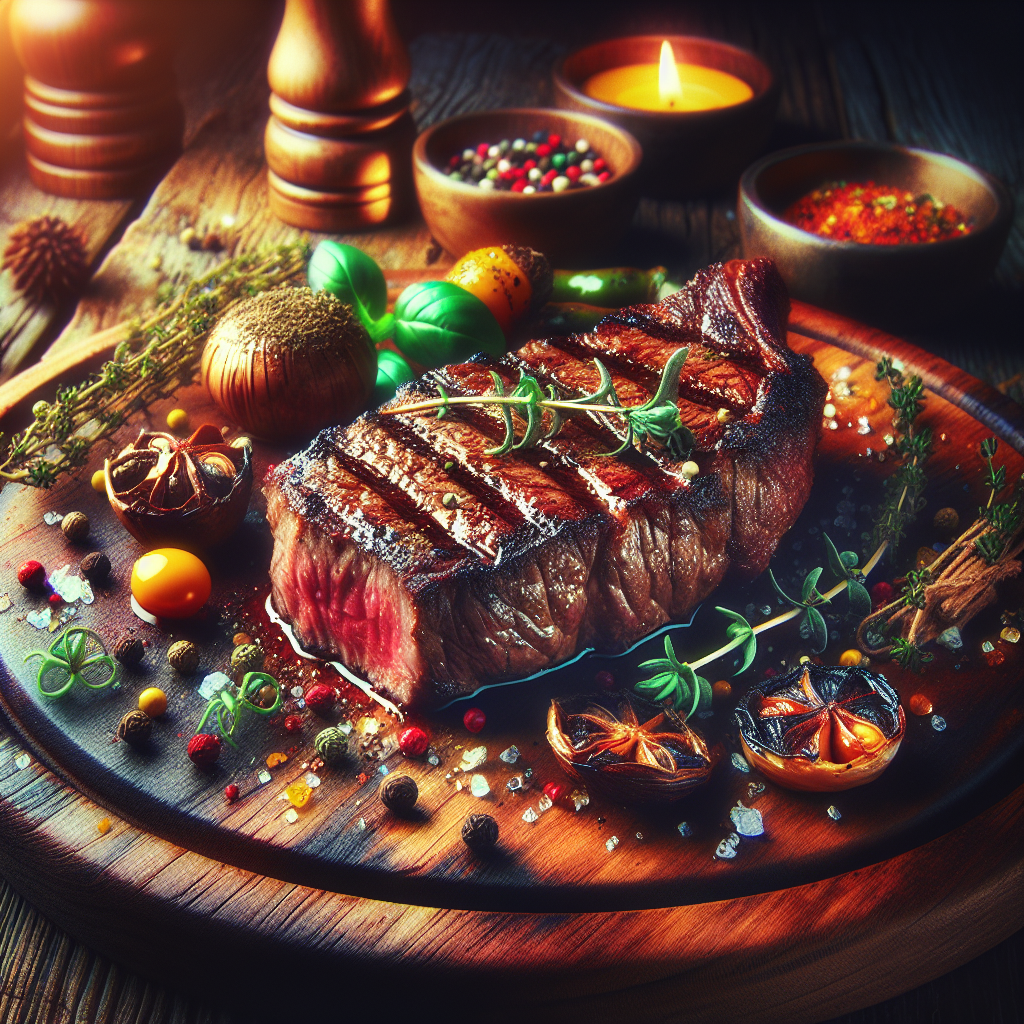Do you have a taste for adventure when it comes to cooking? If so, then you’re in luck! Tastepan.com is your go-to destination for an array of tantalizing recipes, including the finest in wild game cuisine. From succulent venison to flavorful duck, we’ve got you covered with mouthwatering dishes that will take your taste buds on a wild ride. With our easy-to-follow instructions and helpful tips, you’ll be able to create extraordinary meals that will impress even the most discerning of palates. Get ready to embark on a culinary adventure like no other with our Cooking with Wild Game series.

Benefits of Cooking with Wild Game
When it comes to cooking, why settle for the traditional when you can enjoy the excitement and benefits of cooking with wild game? Not only does it offer a unique and adventurous culinary experience, but it also comes with numerous health and environmental benefits that are worth exploring. So, let’s dive in and discover the many reasons why cooking with wild game should be at the top of your list!
Health Benefits of Wild Game
One of the major advantages of cooking with wild game is the exceptional health benefits it provides. Compared to traditional meats, wild game is leaner, meaning it contains less fat and more protein. This makes it an excellent choice for those looking to maintain a healthy diet or manage their weight. Additionally, wild game is rich in essential nutrients such as iron, zinc, and vitamin B12, which are crucial for overall wellbeing.
Another significant health benefit of wild game is that it is often free of hormones and antibiotics frequently found in commercially raised animals. By consuming wild game, you can minimize your intake of these potentially harmful substances, ensuring a healthier and more natural option for you and your loved ones.
Environmental Benefits of Wild Game
Cooking with wild game not only benefits our health but also has a positive impact on the environment. Unlike traditional livestock farming, wild game is sourced from nature itself, reducing the strain on resources such as land, water, and feed. Hunting and fishing for wild game also help control the population of certain species, maintaining a balanced ecosystem.
Furthermore, raising commercial livestock often involves the emission of greenhouse gases and contributes to deforestation. By choosing to cook with wild game, you are supporting sustainable practices and promoting the preservation of natural habitats, resulting in a greener and more eco-friendly approach.
Choosing and Preparing Wild Game
Now that we’ve explored the benefits of cooking with wild game let’s delve into the key aspects of choosing and preparing this delectable protein source. Whether you’re a seasoned chef or just starting out in the kitchen, these guidelines will ensure that you make the most of your wild game culinary adventures.
Selecting Fresh Wild Game
When it comes to wild game, freshness is of utmost importance. Look for suppliers or local markets that source their game from reputable sources and adhere to proper hunting and storage practices. Fresh wild game should have a vibrant color, little to no odor, and firm flesh. It’s always best to ask the seller about the source and handling of the game to ensure you’re getting the highest quality product.
Properly Handling and Storing Wild Game
To maintain the freshness and flavor of wild game, proper handling and storage are essential. Ensure that the game is stored at a cool temperature, preferably between 32°F and 40°F, to prevent bacterial growth. It’s crucial to handle the meat with clean utensils and surfaces to avoid cross-contamination.
Preparing Wild Game for Cooking
Before diving into the cooking process, wild game requires some preparation. This usually involves trimming any excess fat, removing silver skin, and portioning the meat into desired cuts. Marinating the meat can also enhance its flavor and tenderness, which leads us to our next section.
Tips for Tenderizing Wild Game
Wild game can sometimes be tougher than traditional meats, but with the right techniques, you can ensure a tender and juicy result. One popular method is marinating the meat, as this not only adds flavor but also helps break down the muscle fibers, resulting in a more tender texture. Additionally, slow cooking methods, such as braising or stewing, can work wonders in tenderizing wild game.

Cooking Venison
Among the wide variety of wild game options, venison stands out as one of the most popular choices for cooking enthusiasts. Its rich flavor and versatility make it an excellent ingredient for a wide range of dishes. Let’s explore some delightful techniques for cooking venison.
Marinating and Seasoning Venison
One of the keys to getting the most out of venison is marinating. Since venison can be quite lean, marinating not only adds moisture but also infuses the meat with an array of flavors. Common marinade ingredients for venison include red wine, herbs like rosemary and thyme, garlic, and soy sauce. Allow the meat to marinate for a few hours, or ideally overnight, for maximum flavor impact.
Grilling Venison Steaks
Grilling venison steaks is a popular cooking method. Begin by preheating the grill to medium-high heat. Brush the steaks with a bit of oil and season with salt and pepper. Grill the steaks for about four to six minutes on each side or until they reach your desired level of doneness. Remember to let the meat rest for a few minutes before serving to retain its juices.
Roasting Whole Venison
For a more elegant and flavorful experience, consider roasting a whole venison. Start by preheating the oven to a high temperature, around 450°F. Season the meat generously with your preferred blend of spices and herbs, then place it in a roasting pan. Cook the venison in the oven for about 20 minutes per pound, or until the internal temperature reaches 145°F for medium-rare. Allow it to rest before carving and serving.
Making Comforting Venison Stews and Chilis
Venison’s rich and gamey flavor makes it an ideal choice for hearty stews and chilis. To make a delicious venison stew, sauté the meat with onions and garlic until browned. Add vegetables like carrots, potatoes, and celery, along with some broth or red wine. Simmer the stew over low heat for a few hours until the meat is tender and the flavors have melded together. Serve with crusty bread for a satisfying meal.
Cooking Duck
In addition to venison, duck is another prized wild game known for its unique taste and versatility in the kitchen. Whether you’re a fan of crispy skin or tender breast meat, here are some methods to help you master the art of cooking duck.
Marinating and Seasoning Duck
Marinating duck is an excellent way to infuse it with bold flavors. Opt for a marinade that complements the richness of the meat, such as a combination of soy sauce, honey, ginger, and garlic. Allow the duck to marinate for at least an hour or overnight for more intense flavor penetration.
Roasting Duck with Crispy Skin
Roasting duck to achieve crispy skin requires a two-step process. Begin by searing the duck breast in a hot skillet, skin side down, until it turns golden brown. Then transfer it to the oven and roast at a moderate temperature, around 375°F, for approximately 20 minutes per pound. Baste the duck occasionally with its own rendered fat to keep it moist and flavorful. The result will be a perfectly crispy-skinned, succulent duck that is sure to impress.
Pan-Seared Duck Breast
For a quick and flavorful duck dish, pan-searing the breast is a fantastic method. Begin by scoring the skin in a crosshatch pattern, taking care not to cut into the meat. Season the breast with salt and pepper, then place it skin side down in a preheated skillet over medium-high heat. Cook for about five minutes until the skin turns golden and crispy. Flip the breast and cook for an additional three to four minutes, or until desired doneness. Let it rest briefly before slicing.
Creating Flavorful Duck Confit
Duck confit is a classic French dish that involves slow-cooking the duck in its own fat. Start by generously seasoning the duck legs with salt, herbs, and spices such as thyme, bay leaves, and garlic. Place them in a dish and cover with duck fat or a mixture of duck fat and oil. Slow cook the duck in the oven at a low temperature, around 275°F, for several hours until the meat is tender and falling off the bone. The result is a flavorful and luxurious dish that can be enjoyed on its own or used as a component in various recipes.

Exploring Other Wild Game
While venison and duck take the spotlight, there are numerous other wild game options waiting to be discovered in the culinary world. Let’s take a look at a few more options that can add a flavorful twist to your cooking repertoire.
Cooking with Rabbit
Rabbit, known for its delicate flavor, lean meat, and tender texture, is a versatile wild game option that lends itself to various cooking methods. From roasting and braising to grilling or incorporating it into stews and pies, rabbit offers endless possibilities for creating unique and delicious dishes.
Preparing Pheasant Dishes
Pheasant, with its rich, gamey flavor, is a prized bird for hunters and food enthusiasts alike. It can be prepared using similar techniques to chicken, making it an excellent substitute in recipes that call for poultry. From roasted pheasant with herbs to pheasant stir-fries and stews, there are plenty of ways to showcase this elegant bird in your culinary creations.
Delicious Dishes with Wild Boar
Wild boar, with its robust flavor and succulent meat, adds a touch of adventure to your cooking endeavors. Whether you opt for tenderloin, ribs, or ground meat, wild boar can be used in an array of dishes, such as hearty stews, rich ragùs, or even as a gourmet burger patty. Embrace the wild and let your creativity flow when cooking with this versatile game meat.
Serving Quail in Elegant Preparations
Quail, a small yet flavorful bird, is often associated with gourmet cuisine. Whether roasted, grilled, or stuffed, quail lends itself well to elegant preparations. The tender meat and delicate flavor make it an excellent choice for special occasions or when you want to impress your guests with a refined dish.
Enhancing Flavors with Game Accompaniments
To truly elevate your wild game culinary experience, consider pairing your dishes with complementary accompaniments that enhance the flavors and textures of the meat. Here are a few ideas to inspire your creativity:
Pairing Wild Game with Fruity Sauces
The rich flavors of wild game can be beautifully complemented by fruity sauces. Think of a tangy cranberry reduction for venison, a sweet and spicy plum sauce for duck, or an apricot glaze for wild boar. These fruity sauces add a burst of flavor and a touch of elegance to your dishes.
Incorporating Wild Game in Pasta Dishes
Pasta dishes offer a versatile canvas for incorporating wild game. From hearty ragùs made with wild boar or venison to delicate carbonara-style preparations with duck, the combination of rich, gamey meat and pasta creates a harmonious and satisfying flavor profile.
Serving Wild Game with Root Vegetables
Root vegetables, such as carrots, turnips, and potatoes, are the perfect accompaniment for wild game. Their earthy flavors and hearty textures balance out the richness of the meat, creating a well-rounded and comforting dish. Experiment with roasting or mashing root vegetables and serving them alongside your favorite wild game recipes for a complete and satisfying meal.
Adding Nutty Flavors to Wild Game
Nuts can add a delightful crunch and nutty flavor to your wild game dishes. Consider incorporating toasted walnuts or almonds into stuffing for quail or adding a sprinkle of crushed pecans on top of a roasted venison dish. The combination of game meat and nuts creates a delightful contrast in taste and texture.
Cooking with wild game opens up a world of flavors, textures, and culinary adventures. From the health benefits to the environmental advantages, along with the vast variety of recipes and cooking techniques, it’s clear that wild game is a rewarding choice for adventurous home cooks. So go ahead, embrace the wild side of cooking, and let wild game take your culinary creations to new heights!

